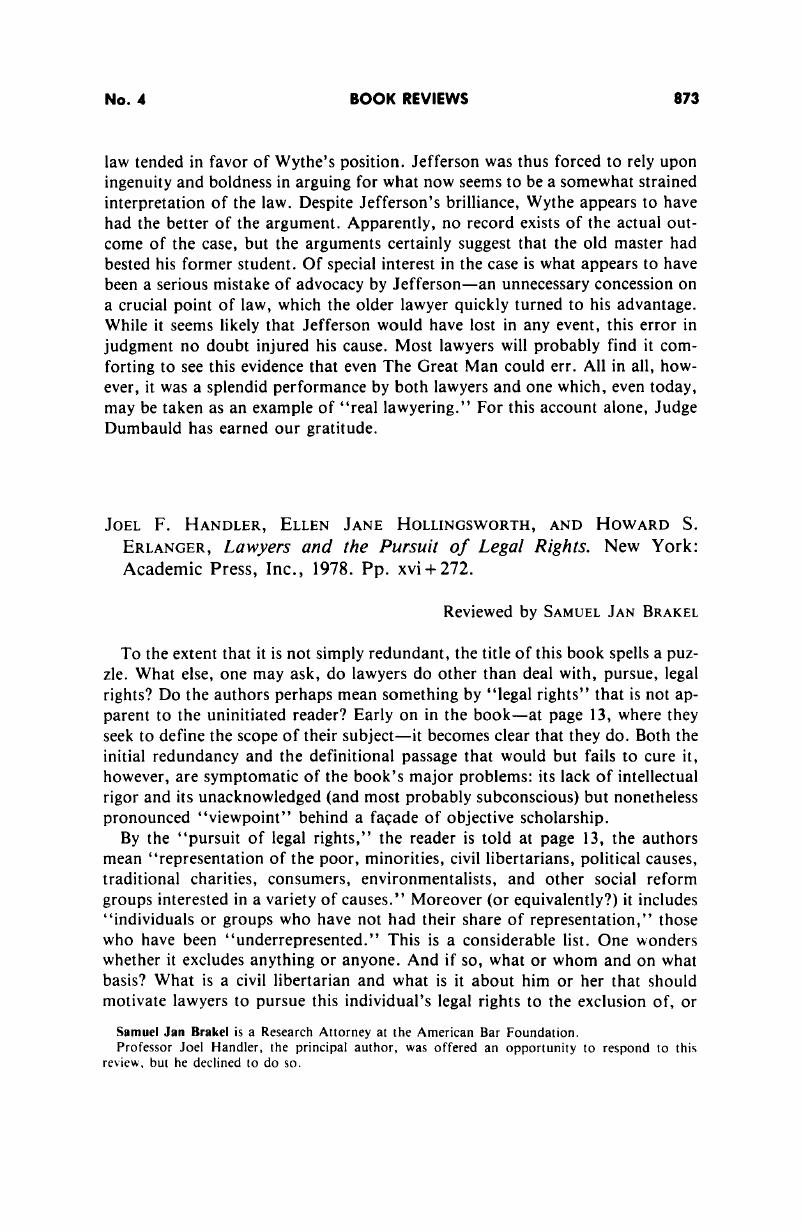No CrossRef data available.
Published online by Cambridge University Press: 27 December 2018

1 The remaining sections of the book contain many more such examples: p. 51–-“strenuous efforts of its enemies to kill or emasculate the [Legal Services] program”; p. 64–-“regionalization threats”; p. 192–-law reform back-up centers as the “target of the enemies of Legal Services.”Google Scholar
2 The Corporation, however, is now in the process of phasing out most of these experiments.Google Scholar
3 For example, the Legal Services Corporation periodically makes available through its various publications and in-house reports new information on items such as caseloads, costs, and the potential demand for the program's services. Challenges to the old information and interpretations can be found in, e.g., Samuel Jan Brake!, “Styles of Delivery of Legal Services to the Poor: A Review Article,” 1977 A.B.F. Res. J. 219. The authors need not accept the new information, much less the “novel” interpretations, at face value, but why they give no indication of being aware of any of it is a mystery.CrossRefGoogle Scholar
4 From “The Legal Services Corporation and the Activities of its Grantees: A Fact Book,” at 17 ([n.p.] Spring 1979). The Corporation's current estimates on the number of people eligible for its services and the caseload capacity of the program are 29 million and 1.5 million–2 million, respectively.Google Scholar
5 At least as early as 1977 the Legal Services Corporation gave wide circulation to the estimate that it takes about $35,000 annually to “support” a single staff attorney. While hardly including all program costs, this figure already computes to an hourly rate of over $23. One public source for this and other cost information is the 1978 GAO report (Report by the Comptroller General of the United States, “Expanding Budget Requests for Civil Legal Needs of the Poor–-Is More Control for Effective Services Required?” esp. pp. 9–10).Google Scholar
6 Most previous estimates–-not necessarily better documented but possibly more credible–-of the time spent on law reform activities have been much lower, often down to 5 percent or less. See, e.g., Samuel J. Brakel, Judicare: Public Funds, Private Lawyers, and Poor People 80 n.9 (Chicago: American Bar Foundation, 1974).Google Scholar
7 “Highly unlikely”? One wonders if this is irony on the part of the authors. The estimates reported are impossible unless at least 40 percent of the law graduates do not go into practice. What this “finding” does do is throw doubt on the responses throughout the study, many of which are likely to be equally self-serving, or, alternatively, on the validity of the sampling process.Google Scholar
8 Indeed, the main problem in all this may be not so much the lack of objectivity–-there is always room for subjective pieces–-as the false claims to it.Google Scholar
9 Cf. John Kenneth Galbraith, The Nature of Mass Poverty (Cambridge, Mass.: Harvard Univ. Press, 1979).Google Scholar
10 Cf. Ivan Illich et al., Disabling Professions (London: Marion Boyars, 1977). One need not swallow the ideas of Illich on “needs,”“clients,” and the “established professions” whole hog nor apply Galbraith's views on mass poverty among nations directly to possibly more particularized conditions and causes of economic inequality in this country, but these works do begin to hint at the scope of the phenomena ostensibly under consideration in this book and the breadth and diversity of perspectives applied to describing and understanding (never mind finding “solutions” for) them.Google Scholar